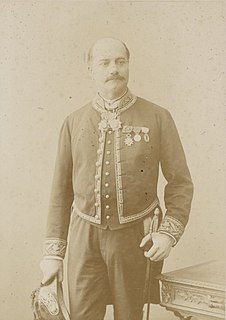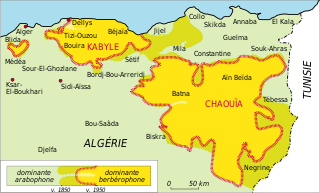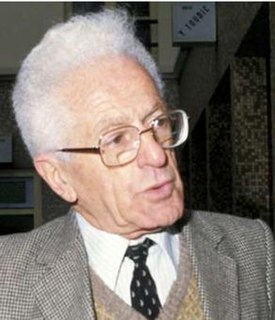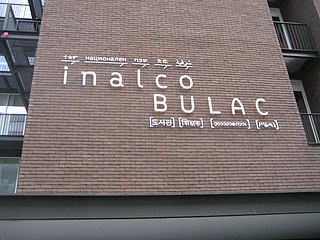Zenaga is a moribund Berber language spoken from the town of Mederdra in southwestern Mauritania to the Atlantic coast and in Senegal. The language is recognized by the Mauritanian government.

Étienne François Aymonier was a French linguist and explorer. He was the first archaeologist to systematically survey the ruins of the Khmer empire in today's Cambodia, Thailand, Laos and southern Vietnam. His principal work was "Le Cambodge", published in three volumes from 1900 to 1904.

Shawiya, or Shawiya Berber, also spelt Chaouïa, is a Zenati Berber language spoken in Algeria by the Shawiya people. The language's primary speech area is the Awras Mountains in eastern Algeria and the surrounding areas, including Batna, Khenchela, Sétif, Oum El Bouaghi, Souk Ahras, Tébessa and the northern part of Biskra.
The Zenati languages are a branch of the Northern Berber language family of North Africa. They were named after the medieval Zenata Berber tribal confederation. They were first proposed in the works of French linguist Edmond Destaing (1915) (1920–23). Zenata dialects are distributed across the central Maghreb, from northeastern Morocco to just west of Algiers, and the northern Sahara, from southwestern Algeria around Bechar to Zuwara in Libya. In much of this range, they are limited to discontinuous pockets in a predominantly Arabic-speaking landscape. The most widely spoken Zenati languages are Riffian in northeastern Morocco and Shawiya in eastern Algeria, each of which have over 2 million speakers.

Rifian, Rif Berber or Rifian Berber is a Zenati Northern Berber language. It is spoken natively by some 1.4 million Rifians of Morocco and Algeria, primarily in the Rif provinces of Al Hoceima, Nador, Driouch, Berkane and as a minority language in Tangier, Oujda, Tetouan and Leɛrayec. In addition, Rifian expatriate communities also speak the language.

The Chaoui people or Shawia are a Berber population inhabiting the Aurès, Batna and Khenchla Oum bwaghi Biskra regions located in and surrounded by the Aurès Mountains. They also live in the Tébessa area and other parts of eastern Algeria coextensive with ancient Numidia, as well as a few adjacent towns in Tunisia. They call themselves Išawiyen/Icawiyen and speak the Shawiya language.

William McGuckin, known as Baron de Slane was an Irish orientalist. He became a French national on 31 December 1838. and held the post of the Principal Interpreter of Arabic of the French Army from 1 September 1846 until his retirement on 28 March 1872. He is known for publishing and translating a number of important medieval Arabic texts.

Mouloud Mammeri was a Berber writer, anthropologist and linguist. Born on December 28, 1917 in Tawrirt Mimun, Ait Yenni, in Tizi Ouzou Province, French Algeria; died in February 1989 near Aïn Defla in a car accident while returning from a conference in Oujda, Morocco.

Maurice Delafosse was a French ethnographer and colonial official who also worked in the field of the languages of Africa. In a review of his daughter's biography of him he was described as "one of the most outstanding French colonial administrators and ethnologists of his time."
Beni Snous is a Berber variety close to Riffian Berber spoken near Tlemcen in Algeria.

South Oran Berber, or Figuig Berber (Figig), is a cluster of the Zenati languages, which belong to the Berber branch of the Afroasiatic family. It is spoken in a number of oases of southwestern Algeria and across the border in Morocco.

Ouargli, or Teggargrent, is a Zenati Berber language. It is spoken in the oases of Ouargla (Wargrən) and N'Goussa (Ingusa) in Algeria.
Émile Masqueray was a 19th-century French anthropologist, linguist, and writer. He was an expert on the Berber–Tuareg peoples of North Africa.
André Basset was a French linguist. René Basset was his father and Henri Basset his older brother.
Marius Canard was a French Orientalist and historian.

Eugène Alexis Girardet was a French Orientalist painter.
Edmond Doutté was a French sociologist, orientalist and Islamologist - both Arabist and Berberologist - but also an explorer of Maghreb.
Jean Deny was a French grammarian, specialist of oriental languages.

Albert Ballu was a French architect. He designed many buildings in French Algeria, including the Cathédrale du Sacré-Cœur d'Oran.


















